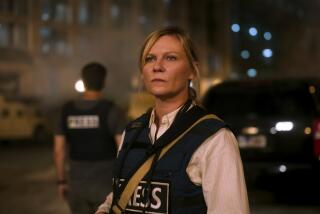Fasten your seat belt and open ‘Che’
A first-rate thriller can be one of the reading life’s most engaging diversions.
Veteran screenwriter Chuck Pfarrer’s carefully plotted and impressively crafted first novel, “Killing Che,” is precisely that: a superior diversion -- and an interesting bit more.
My own admittedly idiosyncratic taxonomy situates the top-shelf thriller somewhat apart from what Graham Greene called his “entertainments” -- works in which the demands of serious literature are grafted onto genre novels as a kind of relaxing exploration. Greene was this form’s master, though John le Carre’s best novels are excellent examples, as is John Banville’s recent foray into detective fiction under the pseudonym Benjamin Black. These, however, are books in which the novelists’ duty to characterization always -- and laudably -- comes before plot.
Sometimes, though, you’re in a mood to let a damn good story trump engaging characterization.
My first-rate thriller does that, while paying enough deference to character not to be grating. It must occupy narrative territory familiar enough to be plausible but novel enough to be engaging. It’s got to make me turn pages out of enthusiasm rather than obligation.
To my mind, the perfect setting in which to read a book like this is a long airplane flight. You need to be engaged enough to be diverted from your immediate surroundings, but not so engrossed that you resent the inevitable interruptions. It ought to permit a brief nap after your second drink, but sufficiently hold your interest so that, say, the 10 1/2 hours from L.A. to London pass without avoidable irritation.
Pfarrer’s book would serve very well, because it’s an immensely engaging book by an author who speaks to his subject with a fascinating authority. It’s also one of those rare thrillers with more than commercial ambitions, most of which are realized in ways bound to gratify the serious reader.
The author sets his story in Bolivia in 1967, when local troops, advised by CIA counterinsurgency experts, hunted down and killed the iconic, Argentine-born darling of the Cuban revolution, Che Guevara, who had infiltrated the country to launch a pan-Andean insurrection. Pfarrer’s protagonist is a CIA contract operative, Paul Hoyle, who comes to Bolivia believing he’s been dispatched to help prevent the eruption of a second Vietnam in Latin America. Soon he finds that he’s in a hunt for Guevara, whose presence in the Andean valleys the agency recently has detected. As it turns out, a lot of people wish the problematic Che dead, and that fact adds a layer of complexity to the plot, as does Guevara’s true-to-life relationship with the revolutionary “Tania” (Heidi Tamara Vunke) and Hoyle’s affair with the conflicted mistress of a Bolivian government minister.
Pfarrer imbues his protagonist with a growing admiration for Che and grants him an unsparing view of his corrupt and murderous government allies. Hoyle’s inner journey and his growing ambivalence toward the presumed demands of counterinsurgency add a further layer of interest to this unusually ambitious thriller. The author’s portrait of Che and of his movements through the Bolivian highlands draws extensively and, perhaps, too meticulously on Guevara’s own diaries and -- so it seems to this reader -- on Jorge Casteneda’s “Companero: The Life and Death of Che Guevara,” which the author scrupulously credits in his acknowledgments.
There is a particularly chilling sequence in which a group of peasants are brutally executed by drunken Bolivian officers as Charlie, one of the American counterinsurgency advisors, stands impotently by. It’s a scene that could stand as an exemplar of all the sinister death squads that have operated across Latin America in the last 50 years:
“Charlie stood trembling in shock and rage. Absurdity was added to brutality when the soldier called after the officers: ‘Your Excellencies? Should I shoot the other one?’
“The major put on his cap and looked back at Charlie. ‘No. Don’t shoot him, take him to Lagunillas.’
“The jeep drove off, and somewhere a pair of crows called out from above the road. Then it began to rain.”
“Killing Che” benefits immensely from the unusual set of real-life credentials Pfarrer brings to this fiction. Before he embarked on his screenwriting career, he served eight years in the Navy SEALs. His combat assignments included commanding a unit that provided sniper cover for the doomed Marine barracks in Beirut, several tours in Central America and the Middle East and, perhaps most relevant, participation in the tracking and capture of the terrorist Abu Abbas, who led the murderous assault on the cruise ship Achille Lauro. He ended his service as an assault element commander, a formidable designation, even within the elite SEALs.
As Pfarrer has said elsewhere of his former unit: “Since the first navy frogmen crawled onto the beaches of Normandy, no SEAL has ever surrendered. No SEAL has ever been captured, and not one teammate or body has ever been left in the field. This legacy of valor is unmatched in modern warfare.”
Pfarrer’s account of his military career, “Warrior Soul: The Memoir of a Navy SEAL,” is notable not only for its precise and illuminating descriptions of unconventional warfare, but also for its compelling and forthright exploration of the memoirist’s psychology. As such, it is one of those too-often overlooked classics of this particular genre of military history, one that deserves to be ranked alongside books like Ernie O’Malley’s “On Another Man’s Wound.” The author’s profound experience of this sort of combat with all its outward tradecraft and profound inner ambiguities lend “Killing Che” an urgent authenticity. It also gives the book an unobtrusive relevance to this nation’s current situation in Iraq and Afghanistan.
“Killing Che” has some of a first novel’s defects. The female characters and their relationships to the men in their lives are more conventionally cinematic than one would prefer, and Pfarrer’s Che is more idealized than realized. Here, a bit more authorial license was in order. The plot, however, benefits nicely from the author’s experience not only as a screenwriter, but also as the author of five graphic novels.
In other words, things move right along -- a not inconsiderable virtue in a first-rate thriller, which “Killing Che” most decidedly is.
More to Read
Sign up for our Book Club newsletter
Get the latest news, events and more from the Los Angeles Times Book Club, and help us get L.A. reading and talking.
You may occasionally receive promotional content from the Los Angeles Times.






